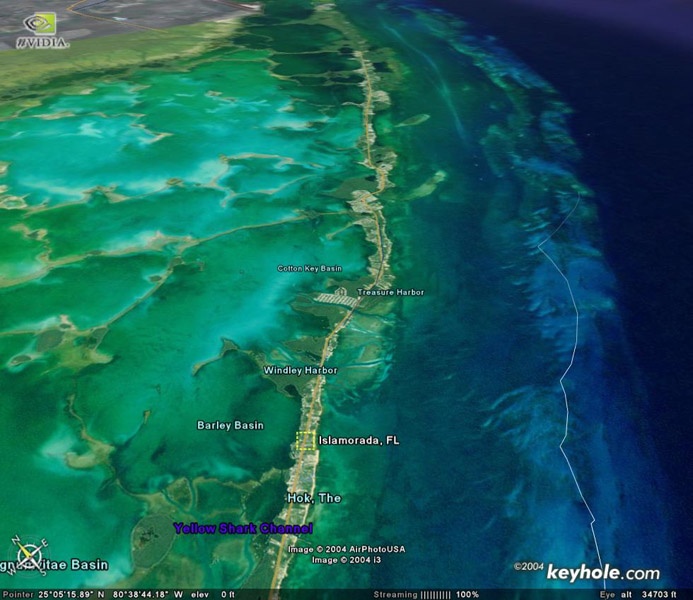Why is it windier in the Florida Keys???
Posted: Thu Feb 17, 2005 4:33 am
The following is part of the thread at: phpbb/viewtopic.php?t=2312964
The actual factors are fairly complex and differ from season to season as well somewhat. Still, a few generalities can be tossed out for discussion.

Image is from HERE
This is a oblique view of the middle to upper Keys and lower mainland of Florida. On the left, you see Florida Bay a relatively large, shallow, slowly circulating water body with abundant sand flats and islands. To the right you have the Florida Reef Tract bordered by the deep, relatively warm fast moving waters of the Florida Current. This water mass is frequently mistakenly referred to as the Gulfstream. More about this HERE .
The Florida Keys present a relatively small land mass in between. So, in the cooler months the waters of the Florida Current in the Straits of Florida may be significantly warmer that the shallow waters of Florida Bay to the west. This sets up a thermal pressure gradient which results in WIND. In general an area of cooler air blows towards an area of warmer air due to atmospheric pressure differences. When you get down to it, wind speed is driven by pressure gradients with higher gradients delivering stronger winds. What contributes to higher gradients is more complex than this simplistic attempt to toss out some ideas on the subject.
In the warmer months the waters of Florida Bay can be warmer than the cooler waters of the Florida Current contributing to an onshore seabreeze even though there is minimal land mass in the Keys. These localized thermal effects can augment or oppose migrating cold fronts and other weather systems that move across the area.
Beyond these factors accounting for more wind, there may also be some observational artifacts, relative to shoreside observations, that contribute to the perception of more wind in the Keys. For one, the anemometer stations along the Florida Reef Tract are generally over 100 ft. above the surface to measure meteoric winds or winds less subject to surface friction/boundary effects. That is they are stronger than what we feel at the surface. Also, these same weather stations are 4 to 8 miles offshore removing them from localized land influences to some degree.
No matter how you dice it though, there does seem to be more wind in the Keys and away from the land, hundreds of square miles of relatively calm, warm riding area.
The actual factors are fairly complex and differ from season to season as well somewhat. Still, a few generalities can be tossed out for discussion.

Image is from HERE
This is a oblique view of the middle to upper Keys and lower mainland of Florida. On the left, you see Florida Bay a relatively large, shallow, slowly circulating water body with abundant sand flats and islands. To the right you have the Florida Reef Tract bordered by the deep, relatively warm fast moving waters of the Florida Current. This water mass is frequently mistakenly referred to as the Gulfstream. More about this HERE .
The Florida Keys present a relatively small land mass in between. So, in the cooler months the waters of the Florida Current in the Straits of Florida may be significantly warmer that the shallow waters of Florida Bay to the west. This sets up a thermal pressure gradient which results in WIND. In general an area of cooler air blows towards an area of warmer air due to atmospheric pressure differences. When you get down to it, wind speed is driven by pressure gradients with higher gradients delivering stronger winds. What contributes to higher gradients is more complex than this simplistic attempt to toss out some ideas on the subject.
In the warmer months the waters of Florida Bay can be warmer than the cooler waters of the Florida Current contributing to an onshore seabreeze even though there is minimal land mass in the Keys. These localized thermal effects can augment or oppose migrating cold fronts and other weather systems that move across the area.
Beyond these factors accounting for more wind, there may also be some observational artifacts, relative to shoreside observations, that contribute to the perception of more wind in the Keys. For one, the anemometer stations along the Florida Reef Tract are generally over 100 ft. above the surface to measure meteoric winds or winds less subject to surface friction/boundary effects. That is they are stronger than what we feel at the surface. Also, these same weather stations are 4 to 8 miles offshore removing them from localized land influences to some degree.
No matter how you dice it though, there does seem to be more wind in the Keys and away from the land, hundreds of square miles of relatively calm, warm riding area.